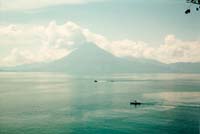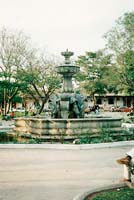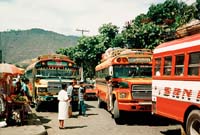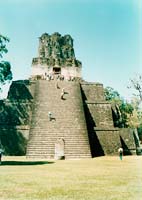Guatemala
A page with
larger images
Panajachel is on the edge of Lago Atitlan,
a beautiful mountain lake bordered by volcanoes along its shores.
Nicknamed Gringotenango because of the presence of so many tourists,
travelers, and expats, Pana is filled with young and old hippies,
dropouts, and drifters.
  The main street
is lined with colorful craft stalls, and wandering indigenia
vendors who are both streetwise and persistent. There are a lot
of vegetarian and open air restaurants, new age shops, and even
a DHL overnight express shipping store. Pana is an odd blend
of funky counter culture commerce and upscale tourist ambiance. The main street
is lined with colorful craft stalls, and wandering indigenia
vendors who are both streetwise and persistent. There are a lot
of vegetarian and open air restaurants, new age shops, and even
a DHL overnight express shipping store. Pana is an odd blend
of funky counter culture commerce and upscale tourist ambiance.
>>> A volcano, seen from the village
of Panajachel, dwarfs local fishing boats on Lago Atitlan in
the Solala district of Guatemala. A trio of 3000 meter volcanoes,
one of which is still active, rise above the lake that surrounds
them.
 
<<< The ornate fountain in the Parque
Central of Antigua, once the grandest colonial city in Central
America. Surrounded by three massive volcanoes, the former capital
of Guatemala was twice destroyed by earthquakes in the 1700's.
The busy plaza in Antigua is filled with indigenias, local ladinos
and tourists from Guatemala City, North America and Europe. Language
school students fill the town along with the crush of tourists
and travelers.
Looming over the town, Volcan de Agua commands your focus as
you turn a street corner and look up. Two more volcanoes, one
with a plume of snake-like smoke, rise in the distance towering
beyond the market. The impact of the volcanoes and reminders
of earthquakes haunt Antigua. Destroyed cathedrals with crumbled
walls, vanished rooftops, gutted interiors, and overgrown weeds
give the town a ghostly ambiance contrasted against its colorful
vibrancy. Haunting and empty, yet filled with shops and visitors.
Crumbling and abandoned ruins populated with street vendors and
tourists.
Small Mayan women, garbed in multi-colored skirts and blouses,
walk with bushel sized baskets balanced on their heads filled
to the brim with produce, crafts, or clothing. They carry their
infants in sling-styled pouches or suspended from their backs.
Dressed in brightly colored clothes and ornately patterned embroidery
on their traditional huipiles the indigenias seem unintimidated
by the gringos. Their grace and dignity combines with their dark
hair and beauty, their easy laughter and coy looks.
  >>>
These brightly painted former U.S. school
buses have been retrofitted and recycled for daily use as public
transportation throughout Guatemala. >>>
These brightly painted former U.S. school
buses have been retrofitted and recycled for daily use as public
transportation throughout Guatemala.
Next to the crowded public market, which
is a labyrinth of shops and vendors, buses come and go in the
massive dirt lot that serves as the bus station. The old U.S.
school buses, some painted in bright primary colors, others still
institutional yellow, are filled with passengers and stacked
with luggage and goods on the roof.
The buses are an amazing experience. People crowd the narrow
aisles that run between small seats which hold three or more
passengers. On many occasions I had difficulty just getting out
of my seat, moving past the people in the aisles and making my
way to the bus door.
Each bus driver has a helper who collects fares by deftly moving
through the mass of humanity. I've observed them crawl out the
window in the front of the bus as it races along. They crawl
along the side using the roof rack as a handhold and the window
frames as footholds, as they make their way to the back door
and reenter the bus.
  <<<
A view of Temple II or Temple of the Masks, in the Great Plaza
of Tikal. Located in the dense tropical jungles of the remote
Peten region of northern Guatemala, Tikal was once one of the
largest Mayan cities in the Americas. <<<
A view of Temple II or Temple of the Masks, in the Great Plaza
of Tikal. Located in the dense tropical jungles of the remote
Peten region of northern Guatemala, Tikal was once one of the
largest Mayan cities in the Americas.
I boarded a small twenty passenger plane
at the Guatemala national airport to Santa Elena in the Peten
jungle. The one hour flight saved me a 15 hour bus ride over
some of the roughest roads in the country.
An airport collectivo, a small passenger van, carried me across
the narrow dirt and rock causeway that connected Santa Elena
to the nearby island village of Flores. I checked into the Hotel
Tucan, a lazy little restaurant and hotel fronting Lake Peten.
I caught another shuttle to the National Park in Tikal. There
I spent five hours wandering around the ruins of Tikal, climbing
the pyramids and watching the tropical birds and monkeys in the
tree canopy.
Crowds of people wandered around the ruins in the blazing tropical
sun. I slipped away from the crowds after seeing the major sites
and explored the less traveled jungle paths and sites. For a
short while I shared a remote set of ruins with a vulture who
remained on the top steps until other tourists arrived and it
flew off.
More about Mexico:
Books:
Lonely Planet Guatemala Travel Guide
Lonely Planet Ruta Maya Guide
Lonely Planet Central America Guide
I, Rigoberta Menchu - Rigoberta Menchu
Time Among The Maya - Ronald Wright
|
|
T
R A V E L M E N U
M
A I N M E N U
Photography by Paul Picus.
Copy by Paul Picus. Copyright © 1996-2009 Paul Picus
Copyright © 1996-2009
Gar Benedick, All Rights Reserved.
comments
|

